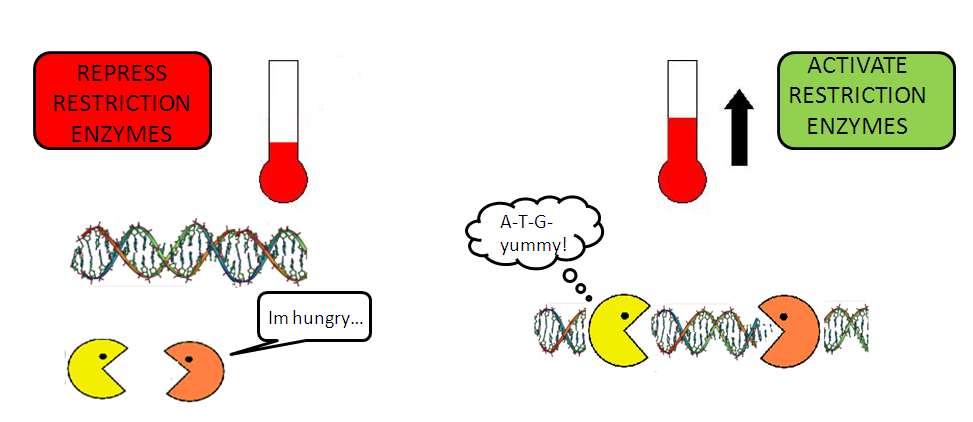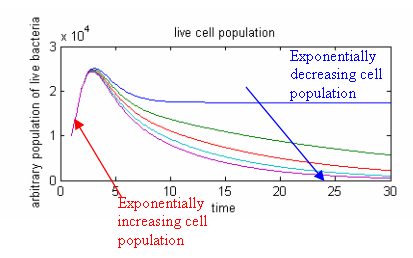Team:Imperial College London/Drylab/Genome deletion
From 2009.igem.org
(New page: {{Imperial/09/TemplateTop}} ==Genome deletion== Killing induced by thermoinduction *[https://2009.igem.org/Team:Imperial_College_London/M3/Modelling Overview]<br> *[https://2009.igem.org/IG...) |
|||
| (27 intermediate revisions not shown) | |||
| Line 1: | Line 1: | ||
{{Imperial/09/TemplateTop}} | {{Imperial/09/TemplateTop}} | ||
| - | ==Genome | + | {{Imperial/09/Tabs/M3/Modelling}} |
| - | Killing | + | |
| - | *[https://2009.igem.org/Team:Imperial_College_London/ | + | <font face='calibri' size='5'><b>Genome Deletion</b></font> |
| - | *[https://2009.igem.org/IGEM:IMPERIAL/2009/M3/Modelling/ | + | <!-- |
| - | + | This module is concerned with killing the E. coli bacteria after successful drug protein production and encapsulation. Killing will be activated by an increase in temperatures from 28°C to 42°C. | |
| + | <br> | ||
| + | The E. coli is killed after it has successfully produced PAH or cellulase, has encapsulated itself in colanic acid and produced trehalose to increase stability of PAH or cellulase during storage. Killing is necessary to make the pill non-toxic or pathogenic, and hence safe for human consumption. This self killing mechanism will be activated by an increase in temperatures from 28°C to 42°C. Therefore, this module will enable us to kill the E. coli after protein production and encapsulation has finished. | ||
| + | <!--<br><br> | ||
| + | [[Image:m3.gc1.jpg]] | ||
| + | <br><br>--> | ||
| + | |||
| + | |||
| + | <!--Initially, the lambda cI promoter is repressed by the protein cI that is produced constitutively under the strong promoter J23114. At 28°C, functional protein cI will bind to the lambda cI promoter to repress it. Restriction enzymes DpnII and TaqI will not be produced. | ||
| + | |||
| + | |||
| + | When there is an increase in temperature (from 28°C to 42°C <cite>1</cite><cite>2</cite>), a change in conformation of the cI protein occurs. Now, protein cI will no longer be able to bind to the lambda cI promoter to repress it, so there will be a de-repression of lambda cI promoter, causing restriction enzymes DpnII and TaqI to be produced. Restriction enzymes digest the genetic material of the E. coli cells and cut the DNA, leading to cell death. | ||
| + | |||
| + | |||
| + | The Dam methylase, which is produced constitutively by a weak promoter J23103, will prevent cell death for redundant basal levels of production of restriction enzymes. This will ensure that unwanted cell death will not occur before we trigger this module. In this way, we can allow E. coli to produce as much PAH or cellulase as possible, with ample time for encapsulation, before we trigger cell death manually. | ||
| + | |||
| + | |||
| + | <!--Dam methylase works by transferring a methyl group to the N6 position of the adenine residues in the sequence GATC[[http://www.neb.com/nebecomm/tech_reference/restriction_enzymes/dam_dcm_cpg_methylation.asp 3]]. As a result, restriction enzymes cannot recognise their intended cleavage site. This means that DNA will not be cleaved in the presence of Dam methylase and E. coli cells will not die. As it competes with restriction enzymes for DNA, at low restriction enzymes concentrations, Dam methylase will be able to methylate DNA and protect it. However, as the concentration of restriction enzymes increase at higher temperatures, the amount of constitutively produced Dam methylase will no longer be sufficient to protect against cell death, and cell killing occurs.--> | ||
| + | |||
| + | Based on the [[Team:Imperial_College_London/M3/Genetic |genetic circuit]], we know that | ||
| + | |||
| + | *The lambda cI promoter is repressed by the protein cI that is produced constitutively under the strong promoter J23114. | ||
| + | *At 28°C, functional protein cI will bind to the lambda cI promoter to repress it. Restriction enzymes DpnII and TaqI will not be produced. | ||
| + | *When there is an increase in temperature (from 28°C to 42°C <cite>[http://www.ncbi.nlm.nih.gov/pubmed/15652426?ordinalpos=13&itool=EntrezSystem2.PEntrez.Pubmed.Pubmed_ResultsPanel.Pubmed_DefaultReportPanel.Pubmed_RVDocSum [1]]</cite><cite>[http://www.ncbi.nlm.nih.gov/pubmed/10235623 [2]]</cite>), there will be a de-repression of lambda cI promoter, causing restriction enzymes DpnII and TaqI to be produced. | ||
| + | |||
| + | ===Our goals=== | ||
| + | [[Image:II09_hitemp_lotemp.jpg|right|450px]] | ||
| + | We aim to: | ||
| + | |||
| + | *Illustrate how temperature correlates to restriction enzyme concentration, and see how it affects the population of live cells, so as to characterise the effects of temperature on cell death. | ||
| + | |||
| + | |||
| + | *Develop a model of the number of live and dead cells. From this, we can monitor the rate of killing and perform data analysis. | ||
| + | |||
| + | |||
| + | <html><a href="https://2009.igem.org/Team:Imperial_College_London/Drylab/Genome_Deletion/Analysis"><img style="vertical-align:bottom;" width=50px align="left" src="http://i691.photobucket.com/albums/vv271/dk806/II09_Learnmore.png"></a></html> about the model assumptions and predictions! | ||
| + | |||
| + | <!--*Model for cell death without Dam methylase protection. | ||
| + | |||
| + | *In a separate model, model for the effects of Dam methylase in protection against cell death. We want to know how much Dam methylase will be necessary to prevent cell death for basal production of restriction enzymes. | ||
| + | |||
| + | --~~~~ Have we done this? | ||
| + | |||
| + | In summary, our model will allow us to characterise the effects of temperature on the parallel production of restriction enzymes DpnII and TaqI, that are required to kill E. coli. We can also characterise the extent Dam methylase can protect E. coli against cell death. (not yet done) | ||
| + | |||
| + | --~~~~ Get rid of this!! We are not going to do it | ||
| + | --> | ||
| + | <!--<biblio> | ||
| + | #1 pmid=15652426 | ||
| + | #2 pmid=10235623 | ||
| + | </biblio>--> | ||
| + | <br> | ||
| + | <br> | ||
| + | |||
| + | ===The system=== | ||
| + | [[Image:m3gci.jpg | 600px]] | ||
| + | |||
| + | The system is made up of 6 ODEs based on the Module 3: Genome deletion genetic circuit. ODEs are also used in modelling the population of <i>E. coli</i>. | ||
| + | |||
| + | <html><a href="https://2009.igem.org/IGEM:IMPERIAL/2009/M3/Modelling/Model1"><img style="vertical-align:bottom;" width=50px align="left" src="http://i691.photobucket.com/albums/vv271/dk806/II09_Learnmore.png"></a></html> about the equations and what they mean! | ||
| + | <br> | ||
| + | <br> | ||
| + | <br> | ||
| + | |||
| + | ===Summary of Simulation results=== | ||
| + | |||
| + | <b><u> Temperature above threshold – Cell population goes to zero </u></b> | ||
| + | |||
| + | [[Image:m3s.6.png]] | ||
| + | [[Image:m3s.7.png]] | ||
| + | |||
| + | *If the temperatures are above threshold, the population growth of live cells will be constrained by the concentration of restriction enzyme. | ||
| + | *The maximum live cell population at a given temperature will also be lower for higher temperatures | ||
| + | *If the lambda cI promoter is strong, there will be a higher rate of cell death than cell growth; we will see a decrease in live cell population. However, if lambda cI promoter is weak, there might not be enough killing, so we will only see a reduction in growth of cell population, ie: a slower increase in population. | ||
| + | |||
| + | <html><a href="https://2009.igem.org/Team:Imperial_College_London/Drylab/Genome_Deletion/Simulations"><img style="vertical-align:bottom;" width=50px align="left" src="http://i691.photobucket.com/albums/vv271/dk806/II09_Learnmore.png"></a></html> about the simulations! <br><br><br> | ||
| + | |||
| + | ===Conclusions=== | ||
| + | |||
| + | *A decrease in live cell population means that cell death is greater than cell growth, due to the killing by restriction enzyme. This is when M3 has fully kicked in. | ||
| + | |||
| + | *At the threshold temperature, cell death balances cell reproduction, and we would notice a straight line in the live cell curve. Above this temperature, cell death dominates, and a decrease in cell population will be observed. | ||
| + | |||
| + | ===References=== | ||
| + | |||
| + | [1] Jechlinger W, Glocker J, Haidinger W, Matis A, Szostak MP, and Lubitz W. Modulation of gene expression by promoter mutants of the lambdacI857/pRM/pR system. J Biotechnol 2005 Mar 2; 116(1) 11-20. doi:10.1016/j.jbiotec.2004.10.002 pmid:15652426. | ||
| + | |||
| + | [2]Jana NK, Roy S, Bhattacharyya B, and Mandal NC. Amino acid changes in the repressor of bacteriophage lambda due to temperature-sensitive mutations in its cI gene and the structure of a highly temperature-sensitive mutant repressor. Protein Eng 1999 Mar; 12(3) 225-33. | ||
| + | |||
| + | [3] Alon, U (2006) An Introduction to Systems Biology: Design Principles of Biological Circuits - Chapman & Hall/Crc Mathematical and Computational Biology | ||
{{Imperial/09/TemplateBottom}} | {{Imperial/09/TemplateBottom}} | ||
Latest revision as of 21:04, 21 October 2009

Genome Deletion
Based on the genetic circuit, we know that
- The lambda cI promoter is repressed by the protein cI that is produced constitutively under the strong promoter J23114.
- At 28°C, functional protein cI will bind to the lambda cI promoter to repress it. Restriction enzymes DpnII and TaqI will not be produced.
- When there is an increase in temperature (from 28°C to 42°C [http://www.ncbi.nlm.nih.gov/pubmed/15652426?ordinalpos=13&itool=EntrezSystem2.PEntrez.Pubmed.Pubmed_ResultsPanel.Pubmed_DefaultReportPanel.Pubmed_RVDocSum [1]][http://www.ncbi.nlm.nih.gov/pubmed/10235623 [2]]), there will be a de-repression of lambda cI promoter, causing restriction enzymes DpnII and TaqI to be produced.
Contents |
Our goals
We aim to:
- Illustrate how temperature correlates to restriction enzyme concentration, and see how it affects the population of live cells, so as to characterise the effects of temperature on cell death.
- Develop a model of the number of live and dead cells. From this, we can monitor the rate of killing and perform data analysis.
 about the model assumptions and predictions!
about the model assumptions and predictions!
The system
The system is made up of 6 ODEs based on the Module 3: Genome deletion genetic circuit. ODEs are also used in modelling the population of E. coli.
 about the equations and what they mean!
about the equations and what they mean!
Summary of Simulation results
Temperature above threshold – Cell population goes to zero
- If the temperatures are above threshold, the population growth of live cells will be constrained by the concentration of restriction enzyme.
- The maximum live cell population at a given temperature will also be lower for higher temperatures
- If the lambda cI promoter is strong, there will be a higher rate of cell death than cell growth; we will see a decrease in live cell population. However, if lambda cI promoter is weak, there might not be enough killing, so we will only see a reduction in growth of cell population, ie: a slower increase in population.
Conclusions
- A decrease in live cell population means that cell death is greater than cell growth, due to the killing by restriction enzyme. This is when M3 has fully kicked in.
- At the threshold temperature, cell death balances cell reproduction, and we would notice a straight line in the live cell curve. Above this temperature, cell death dominates, and a decrease in cell population will be observed.
References
[1] Jechlinger W, Glocker J, Haidinger W, Matis A, Szostak MP, and Lubitz W. Modulation of gene expression by promoter mutants of the lambdacI857/pRM/pR system. J Biotechnol 2005 Mar 2; 116(1) 11-20. doi:10.1016/j.jbiotec.2004.10.002 pmid:15652426.
[2]Jana NK, Roy S, Bhattacharyya B, and Mandal NC. Amino acid changes in the repressor of bacteriophage lambda due to temperature-sensitive mutations in its cI gene and the structure of a highly temperature-sensitive mutant repressor. Protein Eng 1999 Mar; 12(3) 225-33.
[3] Alon, U (2006) An Introduction to Systems Biology: Design Principles of Biological Circuits - Chapman & Hall/Crc Mathematical and Computational Biology
 "
"







